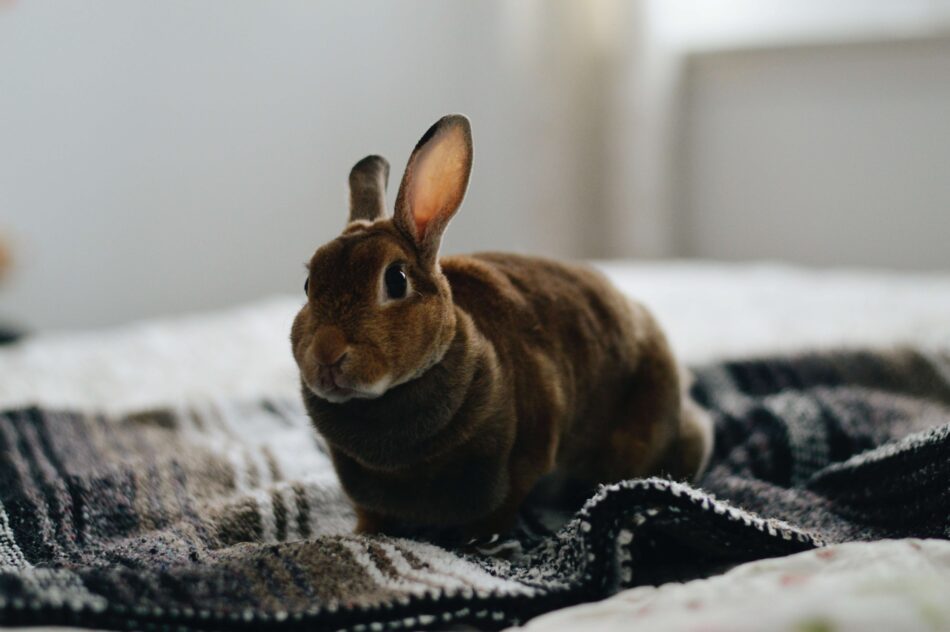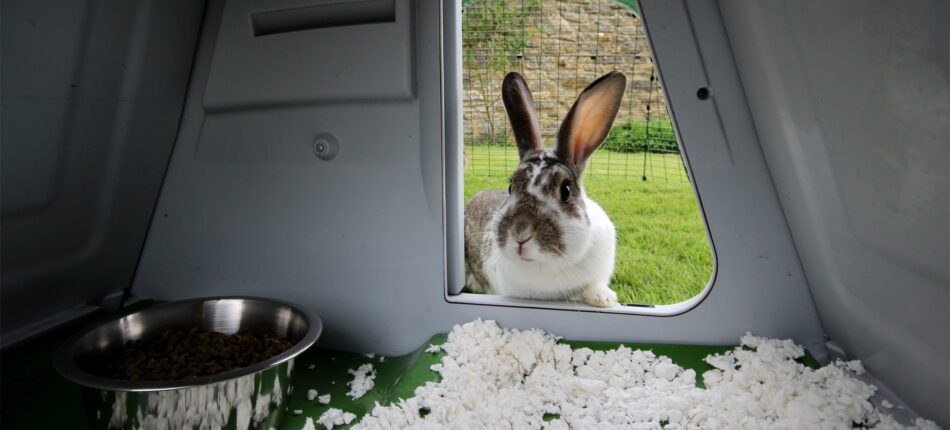Keeping Your Home Clean with Indoor Rabbits
Are you considering adding a rabbit to your family? Or thinking about bringing an outdoor bunny indoor for a season, or even permanently?
Like other small pets, rabbits are very interesting companions to share a home with. They’re easy to care for, build bonds with their families, and don’t require a large amount of space. But unlike other small pets, rabbits are highly adaptable when it comes to their lodging. They can be housed indoors or outdoors, and adapt quickly to a wide variety of environments.
Keeping rabbits indoors allows for closer interaction with them, and also eliminates certain risk factors that come along with outdoor living – such as predators and harsh weather. By keeping your rabbit inside, you’ll also be able to observe their personality and behaviors much more closely. By sharing your living space with your bunny, you won’t have to miss out on a single binky, flop, sprawl, or purr from your furry-family member!
As with any pet, you’ll need to maintain your bunny’s abode to keep it smelling and looking fresh. But with proper placement and cleaning measures, having a pet rabbit indoors can be an aesthetically pleasing and enriching addition to your home!
Boundaries for your bunny
Like small children, bunnies are very curious and don’t always know what’s friend or foe before testing it! It’s very important to take the following rabbit-proofing measures before allowing your bun to explore the inside of your home:
- Make sure your rabbit does not have access to electrical wires such as electronic cables, lamp cords, etc.
- Close off any small spaces that your bunny may try to squeeze into.
- Let everyone in your home know when your rabbit has run of the house to make sure no outside doors get left open.
- Consider blocking off access to wooden furniture that may be enticing to chew on, as treated wood is harmful to rabbits.
For a more exhaustive list of indoor rabbit-proofing, visit: How to Rabbit-Proof Your House.
While you should aim to give your rabbit as much room to stretch their legs outside of their hutch as possible, it’s a good idea to limit your rabbit to specific areas of your home to explore, such as one room or in a rabbit playpen. You’ll be able to keep up with your bunny much easier than if they had free-rein of your house, and having boundaries will make them feel safe and secure.
Litter boxes are not just for cats
Did you know that you can litter box train your rabbit? Like cats, rabbits can be taught to utilize a litter box when nature calls!
Rabbits don’t have quite the instinctive drive to use a litter box as their feline friends, but with a little practice and patience they’ll get the hang of it.
Basic litter box training for rabbits:
- Placement is key! Find where your bunny likes to relieve themselves (usually a corner or other secluded spot) and place their litter box in the exact same location.
- Use some of your rabbit’s eliminations to “bait” the litter box. Pick up some of your bunny’s droppings and empty them on top of the litter. You can also mop up some urine with an unscented tissue or paper towel to place in the litter box.
- Choose a litter box or pan that is an appropriate size for your bunny. If your rabbit uses a corner as their toilet, consider buying a corner-mounted litter box.
- Use a rabbit-appropriate litter (not cat litter!) for your bunny’s litter box.
- Keep your bunny’s litter box in close proximity for the first few weeks. After they get the hang of using it, you can move it to a specific room or keep it in their hutch for them to scurry off to when nature calls!
Be patient when training your rabbit to use a litter box, and expect accidents to happen! For more information on litter box training your rabbit, check out: How to Litter Train Your Rabbit.
When and how often to clean your rabbit’s home
Even if your rabbit is litter box trained, their enclosure will need to be cleaned regularly. Many factors determine how often your bunny’s home needs to be refreshed. Male or female, spayed or neutered, and the size of their enclosure all play a part in how often bedding and hutches will need to be cleaned.
A male rabbit that has not been neutered will have a natural “musky” smell, both from his scent glands and in his urine. Intact male rabbits are also more likely to spray to mark their territory, making eliminations outside of their litter box a regular occurrence (high-sided or enclosed litter boxes are ideal for male rabbits!). Intact females are also known to mark with urine more so than spayed females. However, thanks to their anatomical differences from males, they aren’t quite as messy with their marking!
Use an unscented bedding for your rabbit’s enclosure and litter. While it may sound nice to have a scented bunny enclosure, many added perfumes or scents can be irritating to a rabbit’s sensitive sniffer! Stick with natural odor-absorbing beddings such as recycled paper, pine shavings or pellets, or aspen shavings. Avoid using any bedding that is made from cedar, as the oils can be toxic to your bunny. Straw makes for interesting bedding, but will mold easily once it’s wet, resulting in more frequent changes.
Plastic rabbit hutches are much easier to keep clean than their wooden counterparts, as they do not absorb odors. They’ll also last longer since rabbits nibble on wood to trim their ever-growing teeth! Hutches such as the Eglu Go Rabbit Hutch offer ample ventilation to help air out any stale odors and allow for faster drying times after cleaning.
Rabbit-friendly cleaners
There are many commercially available rabbit-friendly cleaners and sprays that can be used safely around your bunny – just be sure to check the labels for use around rabbits specifically. Sprays formulated with enzymes are great for a quick refresh in the room your rabbit is housed in or in between cleanings – particularly if you have a male rabbit! Simply spray on your bunny’s bedding, litter, or hutch to neutralize odors for up to 24 hours. Again, just be sure to adhere to the manufacturer’s instructions on the bottle!
A quick and easy DIY cleaning solution can be made by mixing equal parts vinegar and warm water for your rabbit’s hutch and accessories. Vinegar is one of the safest and effective cleaning agents for use around bunnies, but if you don’t like the smell of vinegar, this mixture can be diluted even further – up to 1 part vinegar to 10 parts water while still maintaining its cleaning ability. Refrain from adding any “smelly” agents such as essential oils, scent boosters, or other extras to your homemade cleaning solution.
Cleaners to avoid around your bunny
A common additive to cat litter boxes for odor-elimination is baking soda, but it is one of the substances that is toxic to bunnies in large amounts.
Other harmful cleaners or odor-eliminating substances that are hazardous to rabbits include:
- Aerosols, or air fresheners
- Chlorine bleach or ammonia
- Detergents or dishwashing liquid
- Powdered cleaning chemicals
- Floor cleaners, both for hard flooring and carpets
- Wood furniture cleaners and conditioners
It’s important to keep any areas your rabbit may explore free of these substances, including any rooms of your home that they will have access to. Bunnies may try to dig or nibble on carpets, baseboards, or furniture legs, so be sure to either keep them away from these objects, or to only clean your home with rabbit-safe options.
As always, if you suspect your rabbit has ingested or come into contact with a harmful substance, contact your veterinarian right away.
Your rabbit and us
At Omlet, we strive to help you reduce time cleaning and maintaining your rabbit’s area so there’s more time for play! With our extensive line of rabbit products, you’ll find everything you need to make indoor-rabbit ownership easy and enjoyable. Zippi rabbit runs, playpens, and tunnels allow you to customize the ultimate indoor rabbit playground, with plenty of space for them to “binky”, zoom, sprawl, and hop to their heart’s content! Our products are fully customizable to your space and preferences, and can be modified as often as you’d like to keep your rabbit’s space engaging and enriching.
Whether you’re bringing your rabbit indoors for the season, or making a more permanent housing change, we’re here to help! Have questions about transitioning your outdoor rabbit indoors or about products that will help your rabbit adjust to life indoors? Message us below!

This entry was posted in Rabbits
